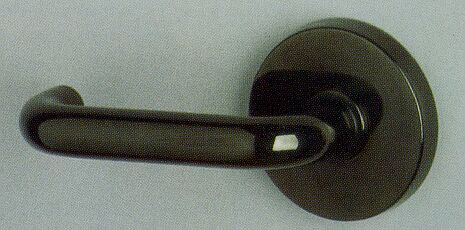NEW SEARCH NEW SEARCH, STATE - NSW
First Prev
DISCLAIMER:
Whilst all care is taken to provide accurate information with respect to the item described, the Independent Living Centre (ILC) is not involved in product design or manufacture, and therefore not in a position to guarantee the accuracy of the information provided. Selection of equipment, which is both suitable and appropriate for individual needs remains the responsibility of the person(s) considering requisition, and no responsibility is taken by the ILC for any loss or injury caused through use of the equipment or alleged to have arisen through reliance upon information provided. As information is subject to change any enquiries should be directed to the manufacturer.
Item Details
Buyers Guide - Door Handles And Hardware
ILC Reference NO 81:56:001
Item sourced from ILC NSW database

Short Description
Door handles and other door hardware may need to be managed with one hand and or with reduced hand function. Lever handles enable ease of grip and benefit form the assistance of gravity to operate, whereas knobs require fine finger control and good grip.
Price Guide
Approx Price: $0.00
Price Date: 08/01/2008
Suitable lever handles may be available at local hardware stores.
POA
More Details
POINTS TO CONSIDER WHEN BUYING DOOR HANDLES:
. Practicality of changing existing handles.
. Ease of operation of handle.
. Does the client have reduced hand strength or full strength in one hand only.
. Comfort of grip. AS1428.2 suggests that the shape of the handle will be such that the hand of a person who cannot grip will not slip from the handle during operation of the latch.
. A "D" shaped lever handle that almost returns to the door will prevent a hand sliding off when the handle is facing downward.
. Clearance between the handle and the backplate or door face should be 35 - 45mm. (Too little clearance will not allow fingers to be hooked over the handle, while too much clearance may allow the wrist to slip through.)
. Height at which handles should be fitted - 900 to 1100mm.
. D handles are preferred on sliding doors and should be located at a
minimum of 60mm from the door jamb when the door is opened or closed.
. Options - devices to assist with door knob operation are commercially available for domestic use.
- slip resistant materials may assist the grip on a door handle.
POINTS TO CONSIDER WHEN BUYING DOOR LOCKS:
. Appropriateness of lock to situation.
. Ease of operation.
. The skills of those using the lock.
AVAILABLE FEATURES:
. Standard key locks and deadlocks.
. Pushbutton locks.
. Combination locks (manual or electronic).
. Electric door locks with pushbutton or remote control.
. Key card insertion for lock release.
. Privacy indicator bolts - enlarged turn snibs are preferred .
OPTIONS - Key turner to facilitate grip on key.
SAFETY FEATURES:
. Contact suppliers for specifications about overcoming power failures on electronically operated doors to make sure there is an emergency breakout or other opening mechanism.
. Locks with locking over-ride mechanism on external fitting - so in an
emergency can unlock from outside with coin, screwdriver or snib fitting.
. Escape hinges fitted to an inward opening door allowing the door to be lifted out of its frame from outside the room. This feature is valuable in situations where the occupant requiring emergency assistance (or their wheelchair) is blocking the path of an inward opening door.
. Installing alternative locking systems and automatic doors may impact upon fire egress. Electronically controlled access doors should release in fire situation, initiated by the activation of a smoke detector. Contact your local fire protection company for more advice.
For further information contact the architectural hardware consultant of a manufacturing / distributing company, specialist locksmiths and architectural hardware retailers. Check the yellow pages.
Standards
For some types of equipment, specific Australian or other Standard(s) are applicable to the materials used in, the manufacturing processes applied to and the installation of products. Compliance with relevant Standards is indicated by written certification that a product has been tested and assessed as compliant with specified Standards. Purchasers are advised to check with the supplier or manufacturer of this item as to its compliance with relevant Standard(s).
For public buildings and any facility which must comply with AS1428.1:
AS 1428.1 - Design for Access and mobility, Part1: New building work" is the relevant standard which includes specifications on door controls in Section 11.
"The door handle and related hardware shall be of the type that allows the door to be opened with one hand.
Note:
1 Lever handles are preferred because doorknobs do not provide an adequate grip for people with hand impairment.
2 The handle should be such that the hand of a person who cannot grip will not slip from the handle during the operation of the latch.
3 Knobs on bolts and snibs should be designed so that they provide an easy grip for the hand.
4 In certain situations, compliance with this item may necessitate the use of sliding or power-assisted doors.
Where lever handles are provided the clearance between the handles and The back plate or door face at the centre of the handle shall be not less than 35mm and not more than 45mm. " (AS1428.1-2001)
Supplier Information - click to supplier for contacts details
ASSA ABLOY AUSTRALIA PTY LTD,
TAREN POINT, NSW
JAMES, J & CO PTY LTD,
CREMORNE, NSW
KEELER HARDWARE PTY LTD,
WILLOUGHBY, NSW
Additional /images
No additional /images apply to this item
First
Prev ![]()
![]() Next
Last
Next
Last
